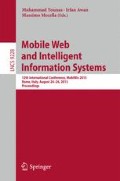Abstract
When large-scale disasters occur, evacuees have to evacuate to safe places quickly. In this paper, we propose an automatic evacuation guiding scheme using mobile nodes of evacuees. Each node tries to navigate its evacuee by presenting an evacuation route. It can also trace the actual evacuation route of the evacuee as the trajectory by measuring his/her positions periodically. The proposed scheme automatically estimates blocked road segments from the difference between the presented evacuation route and the actual evacuation route, and then recalculates the alternative evacuation route. In addition, evacuees also share such information among them through direct wireless communication with other mobile nodes and that with a server via remaining communication infrastructures. Through simulation experiments, we show that 1) the effectiveness of the proposed scheme becomes high with the increase of degree of damage and 2) the effect of information sharing through communication infrastructures is higher than that through direct wireless communication.
Access this chapter
Tax calculation will be finalised at checkout
Purchases are for personal use only
Preview
Unable to display preview. Download preview PDF.
References
Aschenbruck, N., Gerhards-Padilla, E., Martini, P.: Modeling Mobility in Disaster Area Scenarios. Performance Evaluation 66(12), 773–790 (2009)
Fall, K.: A delay-tolerant network architecture for challenged internets. In: Proc. of SIGCOMM 2003, pp. 27–34 (2003)
Fujihara, A., Miwa, H.: Disaster evacuation guidance using opportunistic communication: the potential for opportunity-based service. In: Bessis, N., Dobre, C. (eds.) Big Data and Internet of Things: A Roadmap for Smart Environments Studies in Computational Intelligence. SCI, vol. 546, pp. 425–446. Springer, Heildelberg (2014)
Iizuka, Y., Yoshida, K., Iizuka, K.: An effective disaster evacuation assist system utilized by an ad-hoc network. In: Stephanidis, C. (ed.) Posters, Part II, HCII 2011. CCIS, vol. 174, pp. 31–35. Springer, Heidelberg (2011)
Inoue, M., Ohnishi, M., Peng, C., Li, R., Owada, Y.: NerveNet: A Regional Platform Network for Context-Aware Services with Sensors and Actuators. IEICE Transactions on Communications E94–B(3), 618–629 (2011)
Keränen, A., Ott, J., Kärkkäinen, T.: The one simulator for DTN protocol evaluation. In: Proc. of the 2nd International Conference on Simulation Tools and Techniques, pp. 55:1–55:10 (2009)
Lim, G.J., Zangeneh, S., Baharnemati, M.R., Assavapokee, T.: A Capacitated Network Flow Optimization Approach for Short Notice Evacuation Planning. European Journal of Operational Research 223(1), 234–245 (2012)
Martín-Campillo, A., Crowcroft, J., Yoneki, E., Martí, R.: Evaluating Opportunistic Networks in Disaster Scenarios. Journal of Network and Computer Applications 36(2), 870–880 (2013)
Ministry of Internal Affairs and Communications: 2011 WHITE PAPER Information and Communications in Japan. http://www.soumu.go.jp/johotsusintokei/whitepaper/eng/WP2011/2011-index.html
Takizawa, A., Takechi, Y., Ohta, A., Katoh, N., Inoue, T., Horiyama, T., Kawahara, J., Minato, S.: Enumeration of region partitioning for evacuation planning based on ZDD. In: Proc. of of the International Symposium on Operations Research and its Applications, pp. 64–71 (2013)
Uddin, M.Y.S., Nicol, D.M., Abdelzaher, T.F., Kravets, R.H.: A post-disaster mobility model for delay tolerant networking. In: Proc. of the 2009 Winter Simulation Conference, pp. 2785–2796 (2009)
Vahdat, A., Becker, D.: Epidemic Routing for Partially Connected Ad Hoc Networks. Tech. Rep. CS-200006, Duke University (2000)
Winter, S., Richter, K.F., Shi, M., Gan, H.S.: Get me out of here: collaborative evacuation based on local knowledge. In: Proc. of Third International Workshop on Indoor Spatial Awareness, pp. 35–42 (2011)
Author information
Authors and Affiliations
Corresponding author
Editor information
Editors and Affiliations
Rights and permissions
Copyright information
© 2015 Springer International Publishing Switzerland
About this paper
Cite this paper
Komatsu, N., Sasabe, M., Kawahara, J., Kasahara, S. (2015). Automatic Evacuation Guiding Scheme Using Trajectories of Mobile Nodes. In: Younas, M., Awan, I., Mecella, M. (eds) Mobile Web and Intelligent Information Systems. MobiWIS 2015. Lecture Notes in Computer Science(), vol 9228. Springer, Cham. https://doi.org/10.1007/978-3-319-23144-0_1
Download citation
DOI: https://doi.org/10.1007/978-3-319-23144-0_1
Published:
Publisher Name: Springer, Cham
Print ISBN: 978-3-319-23143-3
Online ISBN: 978-3-319-23144-0
eBook Packages: Computer ScienceComputer Science (R0)

